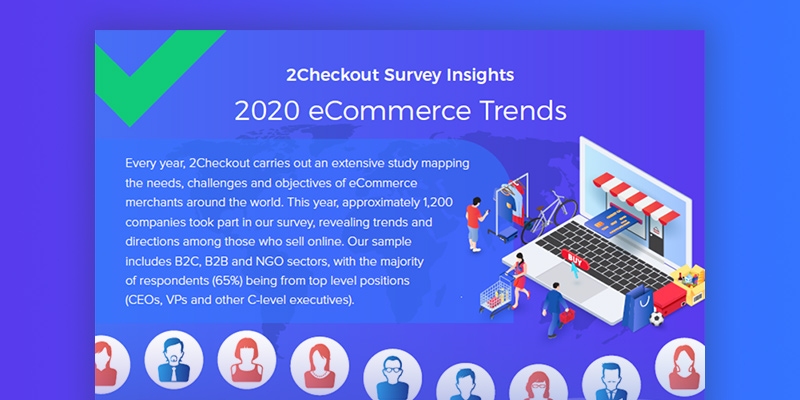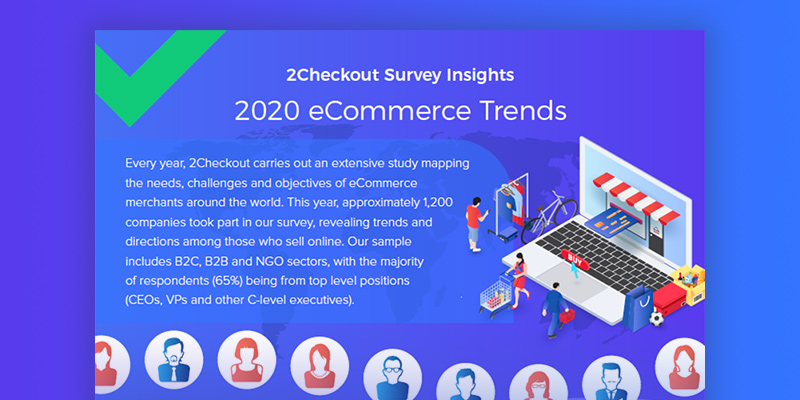We surveyed 1,200 companies who sell online (B2Bs and B2Cs) to get a feel for what matters to them when it comes to digital commerce—priorities, challenges, changes they are planning on making in the new year, and what they’ll continue pursuing. From the sound of things, some interesting changes are coming, but online merchants are also embracing the mentality “if it ain’t broke, don’t fix it.”
Consumers and businesses are buying more and more online and anything they want today they can easily find on the web—from fashion products to drones and cloud-based software applications to subscription groceries…quite the breadth.
Products like these and other new and old product trends all contribute to the anticipated growth of online purchases from $3.53T USD this year to $6.54T USD in 2020 with an increased percentage of retail sales being completed online (14.1% in 2019 to 17.5% in 2021). Why so high? With 57% of the world’s population now having access to the internet, 20% of the world’s population is now making purchases online. The largest group of online purchasers is the GenXers who average 19 transactions per year. But, as millennials land increasingly higher paying jobs, GenXers and their online purchase status will soon be handed over to the younger generation.
To take part in these upward sloped eCommerce trends, companies must follow buyer trends closely and give consumers and businesses alike the experiences they want as they spend their cash. Let’s see how merchants are planning to do this in 2020, based on our survey.
Top priorities for companies in 2020: Customer experience and data analytics
Customer experience came out as a top priority (43% plan on acting on this) for companies who completed our survey, which was a 10% increase from the previous year.
It’s great to hear companies recognizing the importance of customer experience in their business strategy because the experience a customer has before, during, and after a purchase plays such a large role in the success of a company. Their experience can make or break your relationship with them (and with others thanks to the quick dissemination of knowledge via social media). 89% of customers say they will stop doing business with a brand after having had a negative experience, though only 1 out of every 26 of these people will even tell you they had a bad experience. Unfortunately, it’s hard to come back from these events to maintain a good standing in the public eye. In fact, it seems you’ll need to aim to get 12 positive reviews to outweigh every single negative review received. It would probably just be easier to make sure everyone is happy… Additionally, a 5% increase in customer retention because of a pleasant experience with a brand can increase profits anywhere from 25-95%.
Data analytics is another top priority for companies in the coming year. The business management mastermind Peter Drucker said, “If you can’t measure it, you can’t improve it.” Data is the key to measuring customer experience and you don’t truly know what that experience is unless you have data around it. Knowledge of page views, bounce rates, conversion rates, etc. can generate change in the most beneficial business areas.
Other eCommerce priorities in 2020 will revolve around customer needs as well with focus on support, localization, and targeted traffic also being in the works for businesses.
Choosing the right technology viewed as the biggest challenge
To be fair, choosing the right technology can be challenging. Technology is a big investment and it can be difficult to weigh the options and make estimates as to how well a given technology will integrate with your company and to what extent it will generate a positive ROI. Some of the challenges in choosing the right technology lie in finding tools that integrate with your workflow, as well as with the tools already in your technology stack. Ultimately, when selecting a new tool, you want it to enable you to work smarter and not harder. That’s why the assessment of how much time, money, and effort it takes is important. You need to extract enough value to outweigh those downsides.
Other areas where companies expect to struggle in the next year include converting visitors to buyers and customer support.
Budget shift forecasts
Budgets are increasing! 61% of the companies surveyed said that they would be increasing the budget supporting all of their eCommerce operations. Similarly, 62% of companies said that they would be increasing their marketing budget, which will be used in areas such as SEO, paid advertising, and social media. An increased focus on SEO will help their customers find them more easily organically. More money in paid advertising will help them target the specific demographics that connect best with their products.
Targeting and personalization: The big implementation of 2020
Targeting and personalization makes up the biggest project companies are reporting for the coming year. 32% of those surveyed shared that they have already implemented targeting and personalization and another 37% plan to do so meaning approximately three-fourths of surveyed companies are focused on being relevant to users. As personalization becomes more and more common, and big brands such as Netflix and Sephora do it, this is quickly becoming the consumer’s new standard. 91% of consumers say they are more likely to engage with brands who provide personalized recommendations and offers, and 90% of people say they are more likely to make a purchase when a brand personalizes their buying experience. The effect of making customers happy is that brand loyalty increases—as do sales and referrals. Personalization also reduces the cost of customer acquisition by 50%. So many advantages, this simply cannot be ignored.
Mobile apps and chatbots are some additional implementations that companies are considering, but augmented reality and virtual reality seem to be taking a bit of a back burner for most. Why do you think that is, with so much hype around these areas?
Automation in eCommerce
Automated email marketing is still taking the driver’s seat in 2020 out of all the automation options a company could choose from. Why is this? Well, it’s tried and true. It works. Customers are 3x more likely to make a purchase from an email than from social media, and the average order value is also 17% greater. So, 70% of companies plan on using it. Also known as drip emails or trigger-based emails, this form of marketing delivers emails to consumers or business buyers based on actions they take, or where they are in the customer lifecycle and your relationship with them. When people are reached right when they most need it, it increases conversions. According to Epsilon, automated emails get twice as many click rates than poorly timed, one-off emails.
Who manages eCommerce in companies selling online?
It may not come as a shock that eCommerce success normally falls under the marketing team’s responsibility. The reality is that most companies still do not have dedicated eCommerce teams. Marketing ownership in this area has seen a 13% increase in the past year, up from 24% in 2018.
Payment methods online merchants want to adopt
The payment methods a company accepts are very important because they help maximize purchase conversions. Most online businesses are already accepting credit and debit cards, but some up and coming directions they want to introduce include mobile payments, credit cards with installments, and payment methods that are region specific.
Now that consumers are making half of all online purchases from their mobile devices, digital wallets are all the more essential. Some of the top mobile payment methods are recognized names such as Apple Pay or WeChat Pay (popular in Asia), that offer secure, fast, and convenient ways to pay for items found while browsing the web. As mobile payment technology improves, purchases via mobile devices are expected to rise to $503B this coming year from $75B in 2016—this explains why 31% of companies say they want to integrate mobile payment options in the coming year.
Recognizing the region from which someone is accessing an eCommerce site allows businesses to present consumers with local payment options they may feel more comfortable with, instead of the most common internationally accepted methods. Each country is unique in how financial transactions are conducted. In some countries bank transfers are commonplace, or they may have a credit card or debit card specific to their region.
Compliance and consumer privacy
Most of the surveyed companies’ compliance priorities revolve around privacy matters. And while there seems to be more focus on privacy in Europe with the emphasis the EU has been placing on the General Data Protection Regulation (GDPR), California’s Consumer Privacy Act and Brazil’s New General Data Protection Law are not far behind requiring companies to comply in 2020.
It’s not only institutions enforcing privacy compliance. 53% of people are more concerned now than before about their online privacy helping to push standards in this field to higher limits.
Regions for growth
eCommerce still has plenty of room to grow on a global scale. People aren’t just ordering domestically anymore as companies facilitate purchasing and fulfillment regardless of the consumer’s location. 2Checkout’s eCommerce Trends Survey 2020 found that 76% of eCommerce companies want to grow on a global scale, which is up 10% from last year.
Conclusion
With so much potential across the eCommerce landscape, companies need to reassess what has worked for them in the past and where purchasing trends and behaviors are going to demand changes to their digital commerce strategies. For more insights and ideas on what you need to focus on in the coming year, check out our infographic on the 2Checkout Survey Insights on 2020 eCommerce Trends.






